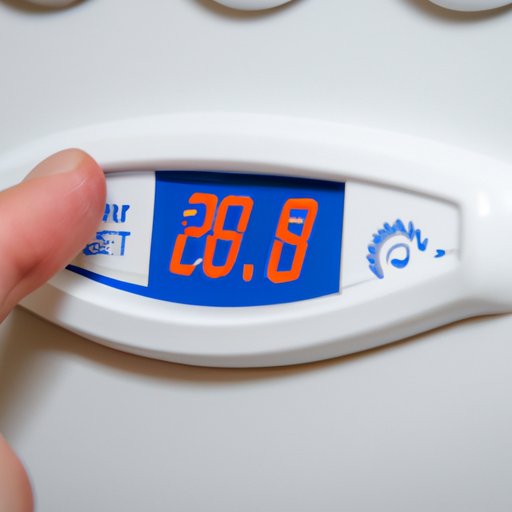Introduction
Your refrigerator is a vital part of your kitchen, so it’s important to make sure that you know what the temperature of your refrigerator should be. This article will provide an overview of the problem and explain how to measure, adjust, and maintain the temperature of your refrigerator. You’ll also learn about the science behind the recommended temperature setting and how to troubleshoot any problems with temperature fluctuations.

How to Measure the Temperature of a Refrigerator
In order to measure the temperature of your refrigerator, you’ll need to get a thermometer. There are several types of thermometers available on the market, but the most accurate one is a digital thermometer. This type of thermometer can be used to measure both the temperature inside the refrigerator and the temperature of the food stored in it.
Once you have a thermometer, you can use it to measure the temperature of your refrigerator. To do this, open the door of the refrigerator and place the thermometer inside. Make sure that the thermometer is not touching any surfaces, as this could give you an inaccurate reading. Close the door and wait for the thermometer to take a reading. After a few minutes, the thermometer should display the temperature of the refrigerator.

What the Ideal Temperature Should Be for a Refrigerator
The ideal temperature for a refrigerator should be between 37°F and 40°F (3°C and 4°C). This temperature range is recommended by food safety experts, as it helps to keep food fresh and safe from bacteria. It is important to note that the temperature may vary slightly depending on the type of model you have and the size of your refrigerator.
The reason why the temperature range is so important is because it helps to slow down the growth of bacteria. Bacteria thrive in warm temperatures, so keeping your refrigerator at a colder temperature will help to reduce the risk of food contamination.
How to Adjust the Temperature of Your Refrigerator
Before you attempt to adjust the temperature of your refrigerator, it is important to understand how your particular model works. Some models may have a manual dial or switch that can be used to adjust the temperature, while others may require you to press a button or enter a code. Once you understand how your model works, you can begin adjusting the temperature.
When adjusting the temperature, it is important to remember that the goal is to keep the temperature between 37°F and 40°F (3°C and 4°C). If you set the temperature too low, the food in your refrigerator may freeze. If you set the temperature too high, the food in your refrigerator may spoil quickly.

Tips for Maintaining the Right Temperature in Your Refrigerator
Maintaining the right temperature in your refrigerator is essential for keeping food fresh and safe. Here are some tips to help you maintain the right temperature:
- Regularly check the temperature of your refrigerator with a thermometer.
- Store food in airtight containers to help keep the temperature consistent.
- Make sure the door seals are properly sealed to prevent cold air from escaping.
Troubleshooting Common Refrigerator Temperature Problems
If you are experiencing temperature fluctuations in your refrigerator, there are a few things you can do to troubleshoot the problem. Here are some common problems and solutions:
- Temperature Fluctuations: If the temperature of your refrigerator is constantly fluctuating, it could be due to a faulty thermostat. Check the thermostat and replace it if necessary.
- Refrigerator Not Cooling Enough: If your refrigerator isn’t cooling enough, it could be due to a blocked air vent. Check the air vents and clean them if necessary.
- Refrigerator Freezing Everything: If your refrigerator is freezing everything, it could be due to a faulty defrost timer. Check the defrost timer and replace it if necessary.
Conclusion
Making sure that your refrigerator is kept at the right temperature is essential for keeping food fresh and safe. In this article, we discussed how to measure, adjust, and maintain the temperature of your refrigerator. We also discussed the science behind the recommended temperature setting and how to troubleshoot any problems with temperature fluctuations. By following these tips, you can ensure that your refrigerator is kept at the optimal temperature.
Keeping your refrigerator at the right temperature is an important part of food safety. By understanding how to measure and adjust the temperature of your refrigerator, you can ensure that your food stays safe and fresh.


